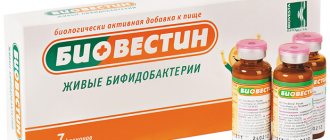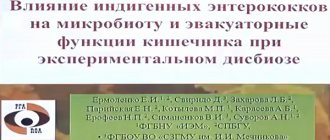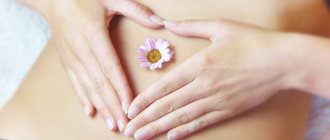Relatively recently, in medical circles there was a statement that the human body, emotions, mood, health and actions are ruled by... bacteria! Their habitat is the intestines. The public was instantly divided into 2 camps. Some argue that bacteria really have the ability to control us, and substantiate their opinion with facts, others recognize this as complete unscientific nonsense and, paradoxically, also give arguments. Let's try to figure it out and understand what microflora is, why it is needed, how bacteria control us, why they are called the second brain, and how to help bacteria make control effective.
What is intestinal microflora
Intestinal flora is what a person receives from the moment of birth and develops during the first 7-10 years. Over time, the set of microorganisms becomes more diverse and consists of lactobacilli, bifidobacteria, fungi and E. coli. They all live in friendly neighborhood not only with each other, but also with pathogenic microflora, preventing it from multiplying and causing harm to the body.
It is believed that pathogenic microflora makes up no more than 15% of the total mass of bacteria. In total, scientific minds count about 100 trillion simple microorganisms in our intestines, weighing on average 1.5 kilograms.
Normally, through nutrition and lifestyle, a person is able to maintain a successful symbiosis of his settlers for a long time. Understanding this process will help significantly improve your quality of life and health.
What is the intestinal microflora responsible for?
Digestion
One of the most important functions of intestinal bacteria is participation in the process of food digestion. This is such a gigantic plant for clearing the wheat from the chaff. When all incoming food, proteins, fats and carbohydrates are broken down under the influence of enzymes, the work of which is activated by the intestines. The intestines are the final, but most labor-intensive and time-consuming part of the digestion process. It is there that, with the help of the microbiome, the process of sorting useful substances from unnecessary garbage begins. The quality of food sorting and the amount of nutrients that are absorbed and assimilated in the intestines depend on how healthy the intestines and the entire digestive tract are.
Protection
One in the field is not a warrior - a phrase that successfully characterizes the work of the intestines. The fewer “good” bacteria there are, the more space there is for the “bad” ones. Beneficial bacteria in the process of vital activity suppress the growth of pathogens of infectious diseases, thereby supporting the protective functions of the entire body.
Immunity
When the body's defenses are strong, the disease will not go away. And immunity, whose homeland is the intestines, plays a big role in this. How does this happen? Intestinal bacteria stimulate the synthesis of immunoglobulins - special proteins that increase the body's defenses against dangerous infections. Immunoglobulins inhabit the intestinal walls, and in sufficient quantities pathogenic microorganisms do not penetrate. Beneficial bacteria also contribute to the maturation of the system of phagocytic cells (nonspecific immunity), capable of absorbing and destroying pathogenic microbes.
Vitamin synthesis
Friendly bacteria living in the intestines are vital for humans to synthesize, store and supply vitamins to the body:
- Vitamin B-12
- Folic Acid/Vitamin B-9
- Vitamin K
- Riboflavin / Vitamin B-2
- Biotin / Vitamin B-7
- Nicotinic acid / Vitamin B-3
- Pantothenic Acid/Vitamin B-5
- Pyridoxine / Vitamin B-6
- Thiamine/Vitamin B-1
Among them are those that are not produced anywhere else in the body. This mission is assigned to bacteria. B vitamins are vital for humans. They keep the nervous system in order, participate in metabolic processes, and help resist stress and depression. If the microflora is disturbed, vitamin synthesis does not occur properly and unpleasant consequences cannot be avoided. In addition, no course of vitamins will help. You will not feel the positive effect simply because they will not be absorbed in the intestines.
MODERN PROBIOTICS. ADVANTAGES AND DISADVANTAGES
Department of Gastroenterology and Dietetics. Northwestern State Medical University named after. I.I. Mechnikov.
Kondrashina Elina Aleksandrovna – candidate of medical sciences, associate professor
MODERN PROBIOTICS. ADVANTAGES AND DISADVANTAGES
Both in Russia and abroad, more and more products related to probiotics appear every year. They are actively studied and prescribed to patients with a wide variety of diseases. Thus, in a 2010 survey of American doctors, 86% of whom were gastroenterologists, 93% of respondents responded that at least some of their patients took probiotics. However, many of these remedies are very burdensome for the patient’s wallet and, moreover, are not always effective. Therefore, an important and often difficult task is to choose the most optimal probiotic for each specific patient.
Definition
The first assumption about the connection between microbes inhabiting the intestines and the spiritual and physical health of a person was first put forward back in 1907 in the works of the famous Russian scientist I.I. Mechnikov. But the term “ probiotic ” itself was first used in 1965 in the works of DM Lilly and RM Stiwell, which were devoted to the problems of correcting intestinal microflora in animals. It has been proposed as an antonym for antibiotics. In 1989, R. Fuller suggested that probiotics have a beneficial effect on the macroorganism.
In 1992, Havenaar R. et al. called probiotics viable cultures of microorganisms that are used in animals and people and have a beneficial effect on their body, improving the properties of the local intestinal microflora. Since 1995, probiotics have been classified as biotherapeutic agents (bacteria) with specific therapeutic properties that suppress the proliferation of pathogenic microorganisms on the mucous membranes of the digestive organs and urogenital tract.
Currently, in foreign literature, most authors refer to the recommendations of the World Organization of Gastroenterologists (2008, 2011). According to them, probiotics are live microorganisms that, when administered in adequate quantities, have a positive effect on the health of the host. This effect can be both local and systemic.
Often, some doctors confuse probiotics with prebiotics. Unlike probiotics, prebiotics do not contain live microorganisms. They are non-absorbable substances that have a positive effect on the human body, selectively stimulating the proliferation and functional activity of its own beneficial microflora.
In addition to probiotics and prebiotics, in the literature you can find such terms as symbiotics and synbiotics. Symbiotics are a combination of several probiotic species of bacteria (for example, ecoflor, bificol, bifidin, etc.). Synbiotics are complex preparations that include pre- and probiotics (floristin, bifiliz, kipacid, etc.).
Mechanisms of the positive effect of probiotics on the human body
The positive effect of probiotics on the human body is associated with the positive properties of the microorganisms they contain. Indeed, most of them include representatives of normal (indigenous) intestinal flora (bifidobacteria, lactobacilli, E. coli, etc.), and the presence of symbiont flora in the intestine is a necessary condition for the adequate existence of the macroorganism. The role of beneficial intestinal microflora for our body is multifaceted; miniature inhabitants of the intestine perform the following functions:
- protective, which consists in protecting the digestive tract from colonization by pathogenic and excessive opportunistic microorganisms (due to bacterial antagonism, production of bacteriocins, organic acids and polyhydric alcohols, creation of a protective microfilm on the surface of the intestinal mucosa);
- enzymatic (enzymes produced by intestinal bacteria take part in the digestion of carbohydrates and proteins, deconjugation of bile acids with the conversion of primary bile acids into secondary ones, cholesterol metabolism, modification of oxalates);
- synthetic (beneficial microflora produces vitamins B1, B2, B6, B8, B12, K, C, nicotinic, folic, pantothenic, lipoic acids, hormones, essential amino acids, antitumor protection substances, neuropeptides, P450-like cytochromes, antioxidants, etc. );
- immune, manifested in maintaining the activity of the phagocytic activity of macrophages and neutrophils, stimulating systemic and local production of secretory Ig A, modulating the Th1/Th2 response and cytokine response, destroying allergens;
- detoxification in the form of participation in the neutralization of exogenous and endogenous substrates and metabolites (nitrates, xenobiotics, histamine, mutagenic steroids, toxic products of protein metabolism: indole, skatole, phenol, etc., superoxide radicals, fecal microbial enzymes: β-glucuronidase, β-glucosidase , nitroreductases, etc.) due to their biotransformation and absorption by bifidobacteria and lactobacilli;
- regulation of absorption capacity, helping to increase the absorption of sodium and water, calcium, iron, magnesium, water, gases, vitamins D, E;
- participation in the regenerative activity of the colon mucosa (thanks to the short-chain fatty acids produced, beneficial intestinal bacteria ensure the regenerative capacity of the colon mucosa and normalize the processes of differentiation of its cellular structures).
Taking into account the diversity of the listed functions, the use of probiotics is not just a replacement therapy for deficient intestinal dysbiosis. These funds can be used to solve more complex problems; their impact on various systems of our body is multifaceted and not well studied.
According to modern ideas, the mechanisms of the positive effect of probiotics on the macroorganism include:
- suppression of pathogenic and excess conditionally pathogenic flora;
- stimulation of reproduction of representatives of indigenous flora as a result of the production of growth-stimulating factors;
- influence on metabolic processes;
- stimulation of the immune system of the macroorganism;
- antiallergic effect;
- anticarcinogenic effect;
- potentiation of the therapeutic effects of drugs (antibacterial, lipid-lowering, antihistamines, regulators of intestinal motility, etc.);
- prevention of reinfections.
Types of probiotics
Currently, probiotics are available in the form of:
- food;
- dietary supplements;
- medicines.
The number of bacteria in different probiotics varies significantly depending on the genus, type and strain of microorganisms, since their effect on the human body is not the same. Probiotic dosages are calculated in colony-forming units (CFU) - the number of viable microorganisms capable of forming colonies on agar medium. To realize therapeutic effects, the number of microbial bodies must be at least 107 in one gram or milliliter.
Probiotic foods
Products with probiotics can rightfully be considered representatives of functional nutrition, which is widely used in Japan and many other developed countries. The term “functional nutrition” was first introduced in 1989. It implies the use of food products that are intended for systematic consumption by all age groups of a healthy population in order to reduce the risk of diet-related diseases, maintain and improve health due to the presence of physiologically active food ingredients. By exerting a regulatory effect on physiological functions, biochemical reactions and psychosocial behavior of a person, these products support physical and spiritual health and reduce the risk of diseases (Shenderov B. A., 2006). The first probiotic functional food product specifically designed to preserve and restore health was a fermented milk product containing lactobacilli, which was introduced to the Japanese market in 1955.
The raw materials for the production of medical food products are most often milk mixtures fermented with bifidobacteria and lactobacilli in combination with kefir starter. Casein hydrolysis products stimulate the proliferation of bifidobacteria, promote the formation of short-chain fatty acids and other metabolites by the microflora, which reduce the intestinal pH and inhibit the growth of excess conditionally pathogenic microflora. Foreign scientists believe that effective medicinal yoghurts should contain at least 108 CFU per 1 ml. Currently, in order to prevent and treat intestinal dysbiosis, not only a wide variety of fermented milk products are produced, but also juices, cereals, pastes, confectionery products, ice cream, and infant formula. Bifidogenic factors based on fructose-oligosaccharides are used as a food additive in more than 500 traditional food products.
In our country, every year more and more products enriched with beneficial microflora appear on the consumer market. Accordingly, for obvious reasons, there is active advertising in the media. However, when talking with patients about choosing a particular fermented milk product, it is advisable to draw their attention to the timing and storage conditions. One should also take into account the fact of pasteurization, which has a detrimental effect on beneficial microflora, since the optimal temperature for the existence of representatives of normal intestinal microflora does not exceed 37 - 400 C. All kinds of flavoring additives, stabilizers, preservatives and dyes also have a negative effect on the microflora. But even if these conditions are met, it must be remembered that the therapeutic effect of probiotic functional food products is quite modest and is possible only with long-term use in patients with dysbacteriosis of exclusively nutritional origin, deficient in the content of representatives of normal microflora.
It seems much more justified to prepare fermented milk products enriched with beneficial microflora at home. For this you need milk and starter cultures containing lactobacilli, bifidobacteria, and thermophilic streptococci. This method allows for better control over the composition of the resulting probiotic product, since the patient independently adds jam, fruits, berries and milk of a certain fat content.
Probiotics – dietary supplements and medications
Depending on the time of creation and improvement, several generations of probiotics are distinguished:
I generation - classic monocomponent preparations, consisting of one strain of microorganisms - typical inhabitants of the intestines (bifidumbacterin, lactobacterin, etc.);
II generation - self-eliminating antagonists (bactisubtil, enterol, biosporin, etc.);
III generation – multicomponent preparations (symbiotics), consisting of several (from 2 to 30) strains of bacteria (Bifilong, etc.) or several types of bacteria (Linex, Bifikol, etc.);
IV generation - combined preparations (synbiotics), consisting of a strain of bacteria and ingredients that promote their growth, reproduction and metabolic activity (bifiliz, kypacid, etc.);
V generation – multicomponent combination preparations (synbiotics), consisting of several types of bacteria and ingredients that promote their growth, reproduction and metabolic activity (floristin, bifiform, etc.).
Probiotics should not be used blindly, but with mandatory consideration of all their components. To help the practitioner select probiotics depending on the microorganisms they contain, we have listed some of them in the table below.
Table
Probiotics and representatives of microflora contained in them
| Probiotics containing bacteria of the genus Bacillus subtilis, Bacillus cereus |
|
| Probiotics containing Saccharomyces bolardii |
|
| Probiotics containing bifidobacteria |
|
| Probiotics containing lactobacilli |
|
| Probiotics containing normal E. coli |
|
| Probiotics containing bifido- and lactoflora |
|
| Probiotics containing bifidobacteria and normal E. coli |
|
| Probiotics containing enterococci |
|
| Probiotics containing bifidobacteria and enterococci |
|
| Probiotics containing bifido-, lactoflora and enterococci |
|
| Probiotics containing bifidobacteria and propionobacteria |
|
Depending on the technological methods used to create probiotic products, they are divided into:
- dry probiotics (bifidumbacterin, lactobacterin, colibacterin, etc.);
- liquid forms (floristin, trilact, bifidum BAG, liquid bifido- and lactobacterins, biovestin, biovestin-lacto, lactoflor, etc.);
- sorption forms (ecoflor, bifidobacterin forte, probifor, bificol forte, etc.);
- capsules with enteric coating (bifiform, linex).
Let's look at the features of each of these groups of probiotics.
Dry probiotics
Just a decade ago, dry probiotics were especially popular. These bacterial preparations contain live microorganisms, both in the form of monocultures and in various combinations, in a freeze-dried state.
Unfortunately, dry probiotics are characterized by low efficiency (Mayansky A., 1999; Zimmerman Ya. S., 2000). The lyophilization process negatively affects the beneficial properties and viability of bacteria. In dry forms, microbes are in a state of suspended animation, so they need up to 8–10 hours to enter an active state. By this time, most of them are eliminated from the intestines (especially in patients with increased intestinal motor activity). After the freeze-drying process, microbial cells lose some of the specific receptors that help them reliably attach to the intestinal mucosa. Such microorganisms have reduced antagonistic activity.
In addition, a significant part of living bacteria dies in the acidic environment of the stomach, the remaining ones are exposed to an alkaline environment, bile acids and pancreatic enzymes in the duodenum, which causes the bacterial membranes to dissolve and the sorption ability of microorganisms, which allows them to fix on the intestinal villi, to further suffer.
But even bacteria that have reached the intestine and are activated in it are not always capable of further colonization of the intestinal mucosa. Moreover, they may be foreign to the patient’s microbiocenosis. Only about a third of the administered dry biological products remain in the human intestine. Another significant drawback of probiotics in this group is the initially low titers of microorganisms contained in them. Therefore, most dry forms of probiotics are characterized by a “delayed” effect of their therapeutic activity (20–30 days or more), moreover, it is often temporary, and after the cessation of maintenance therapy, artificially introduced strains quickly disappear from the intestine and are replaced by random microflora.
In order to increase the effectiveness of therapy with dry probiotics, some authors (Novokshonov A.A. et al., 2001) suggest increasing the daily dose of drugs. However, treatment with megadoses, which consists of increasing the doses of lacto- and bifidobacterins by 1.5 - 3 times in a course of 2 weeks, poses a danger of sensitization. The fact is that laboratory strains of bacteria, especially at excessive doses, are often potential allergens. In addition, they can provoke the development of diarrhea in individuals with subcompensated lactase deficiency. Dry preparations containing E. coli can contribute to the development of not only allergic but also autoimmune reactions.
Liquid Probiotics
In liquid forms of probiotics, bacteria are in a biologically active state, fully retain their antagonistic properties towards pathogenic and conditionally pathogenic flora and are capable of colonizing the intestines within 2 hours. Accordingly, microorganisms realize their therapeutic effect faster than freeze-dried ones.
A valuable component of liquid probiotics are the waste products of bacteria - metabolites (essential amino acids, organic acids, interferon stimulants, vitamins, enzymes, peptides, bacteriocins), which are useful for both microbes and the macroorganism. They:
- reduce the pH of the intestinal contents, thereby improving the action of digestive enzymes and creating an unfavorable environment for pathogenic microbes;
- are an energy substrate for the colon epithelium;
- prevent atrophic and dystrophic processes in the intestinal mucosa;
- regulate differentiation and proliferation of intestinal epithelium;
- improve the absorption of water, gases, calcium, restoring the water-electrolyte balance in the intestinal lumen;
- modulate local immunity;
- have a local anti-inflammatory effect;
- promote the growth, reproduction and metabolic activity of intestinal microflora.
Foreign experts call metabolites of intestinal microflora postbiotics and are actively studying their potential in the treatment of inflammatory bowel diseases.
Liquid forms of probiotics can not only be taken orally, but also used for intraintestinal irrigation, local applications (for example, for stomatitis or cracked nipples), nasal instillation, rinsing and instillation.
A promising modern liquid probiotic is Floristin . It contains lactobacilli (L. acidofilus), bifidobacteria (B. longum, B. bifidum) and their metabolites. Along with other positive qualities inherent in all liquid probiotics, the special advantages of Floristin can be considered:
- a large number of microorganisms contained in it (about 109 CFU of viable and functionally active lactobacilli and bifidobacteria are found in 1 ml of this probiotic);
- the domestic origin of the pharmacopoeial strains of microorganisms contained in Floristin, which have not been subjected to any drying;
- resistance of the B. bifidum BAG strain used for the preparation of Floristin to the effects of aggressive components of gastric juice (hydrochloric acid, enzymes) and bile acids;
- absence of artificial colors, preservatives, flavoring additives, genetically modified components;
- convenient release form (bottle capacity with Floristin - 250 ml).
The survival of biologically active bifidobacteria cells was tested at the Moscow Research Institute of Experimental Microbiology. Gabrichevsky. Floristin is approved for use in children from 1 year of age. Data are emerging on its successful use in children with gastroenteritis of rotavirus etiology, post-infectious enterocolitis, and atopic dermatitis (Ryabchuk F.N., 2014, Nezabudkin S.N. et al., 2014). It should be remembered that the temperature regime for storing liquid probiotics ranges from 2 to 6 0C. This temperature ensures the preservation of a high titer of microorganisms for 3–12 months and is necessary to slow down the growth of microflora. When the ambient temperature rises to room temperature and above, bacteria are activated and produce metabolites that affect the biochemical properties of the environment, which leads to a decrease in the concentration of living microbial cells, and, consequently, a decrease in their therapeutic effect.
Sorption forms
The advantage of sorption forms is the association of microorganisms in microcolonies (20–180 living cells purified from the growing medium), which are fixed on a special sorbent carrier. Coal and carbon-mineral compounds can act as sorbents. Desorption of microorganisms occurs already in the large intestine, where they realize their effect.
Thanks to this structure, due to chemical and electrostatic forces, the interaction of bacteria with the parietal layer of the intestinal mucosa increases and their antagonistic activity increases. Survival increases when bifidumbacteria pass through the acidic environment of the stomach, and high local concentrations are created on the surface of the intestinal mucosa. Sorbent carriers adsorb and remove endo- and exotoxins, pathogenic bacteria and their metabolic products from the body, which helps accelerate the reparative process in the intestinal mucosa. The listed features of sorption forms contribute to a more rapid colonization of the intestines with the bacteria they contain compared to dry lyophilized forms of probiotics.
Enteric-coated capsules
The use of probiotics supplied in enteric capsules is also preferable to the administration of dry forms. The capsules of such drugs are coated with a special enteric coating resistant to hydrochloric acid, which protects the bacteria contained in the drug from destruction when passing through the stomach. As the name suggests, this capsule dissolves in the small intestine, where the microorganisms contained in the preparations are released unchanged without reducing their initial titer. In addition, the capsular shell of some probiotics contains a special nutrient medium necessary for the growth and reproduction of lactic acid bacteria.
Indications for prescribing probiotics
Most Russian specialists invariably associate probiotics with intestinal dysbiosis. Meanwhile, taking into account the various mechanisms of the positive effect of probiotics on the human body, foreign researchers are seriously studying the effectiveness of bacterial preparations in a wide variety of pathological conditions of intestinal and extraintestinal localization.
Thus, there is quite convincing data (Lee MC et al., 2001; Allen SJ et al., 2004; Sazawal S. et al., 2006) on the effectiveness of the use of probiotic strains, including L. reuteri ATCC 55730, L. rhamnosus GG, L casei DN-114 001 and Saccharomyces cerevisidae (boulardii), in children with acute infectious diarrhea. Their use reduced the severity and duration of diarrhea by approximately 1 day. The effectiveness of the use of these probiotic strains of microorganisms in viral gastroenteritis was more convincing compared to bacterial or parasitic infection. There is also evidence of the effectiveness of the use of these same strains for the prevention of acute diarrhea in children and adults.
For antibiotic-associated diarrhea, a positive effect in children and adults was observed with the administration of S. boulardii or L. rhamnosus GG. Research by Plummer S. et al. (2004), Hickson M. et al. (2007) showed the effectiveness of L. casei DN-114 001 in hospitalized adult patients in the prevention of antibiotic-associated diarrhea and diarrhea caused by C. difficile.
According to Isolauri E. et al. (2002) the therapeutic effect of probiotics in inflammatory bowel diseases is multifaceted. It is due to the fact that the introduced bacteria stabilize the immunological barrier of the intestinal mucosa, reducing the local production of pro-inflammatory cytokines, have antagonistic activity towards an unknown bacterium that causes inflammatory bowel diseases, produce antimicrobial substances, promote the restoration processes of the colon mucosa and affect pH intestinal environment. However, often this information is still contradictory and requires further in-depth study.
The use of probiotics containing lactobacilli as one of the drugs used for the eradication of Helicobacter pylori also seems promising. Lactobacilli are not only resistant to most antibiotics used in eradication regimens, but also, due to their antagonistic activity, contribute to the elimination of Helicobacter pylori, while simultaneously having a positive effect on the intestinal microbiocenosis and preventing the side effects of antibiotic therapy ( Kabir AM . 1997; Coconnier M.-H. et al .,1998; Sgouras D. et al., 2004; Sheu B.-S. et al., 2006; Tong JL et al., 2007).
Lactase deficiency (primary or secondary) is currently a problem for 70% of the world's population. These individuals have low levels of intestinal β-galactosidase activity. In this case, lactose acts as an indigestible, osmotically active carbohydrate ( Roberfroid M., 2000). Administration of probiotics containing Streptococcus thermophilus and Lactobacillus delbrueckii bulgaricus, according to Sanders ME (1993), Montalto M. et al. (2006) improves the enzymatic activity of intestinal microorganisms and, accordingly, increases the digestion of lactose, reduces the symptoms of lactase deficiency, slowing down the transit of contents through the digestive tract.
Evidence is accumulating on the use of certain probiotics for the prevention of atopic dermatitis. Thus, in their study, Osborn DA and Sinn JK (2007) showed the effectiveness of prescribing probiotics to pregnant women and newborns under 6 months of age.
There is evidence that some strains of probiotics and prebiotic oligofructose have immunostimulating effects (Schumann C. et al., 2002). Indirect evidence of this was obtained in studies aimed at preventing acute infectious diseases (nosocomial diarrhea in children, influenza), as well as in studies assessing the antibody response to vaccines.
It is assumed that probiotics reduce the duration of acute respiratory infections ( Lenoir-Wijnkoop I, 2007) , sensitivity to pain ( Konturek PC, 2011) , and increase the effectiveness of other drugs for bacterial vaginosis ( Senok AC, 2009) .
The problem of low effectiveness and side effects of probiotics
Unfortunately, probiotics do not always demonstrate sufficient effectiveness. Often the lack of the expected result is due to insufficient examination of patients. Thus, doctors often attribute all the patient’s problems to intestinal dysbiosis, forgetting about more serious diseases hiding under its mask and requiring a different therapeutic approach.
In other cases, bifido- and lactose-containing drugs are prescribed “blindly”, without first destroying opportunistic bacteria. The latter occupy all free adhesion sites on the mucous membranes, so the microorganisms introduced as part of the probiotic simply have nowhere to colonize. Some patients (for example, those with severe intestinal dysbiosis) require longer treatment than that indicated in the instructions, creating large concentrations of microorganisms in the intestines.
In addition, it should be taken into account that in the intestines of a healthy person various types of bifidobacteria, lactobacilli, and Escherichia coli are found, and the individual predominance of different strains in different patients is a proven fact. Therefore, it would be optimal to first determine in vitro the dominant strains of one or another type of normal microflora and their biocompatibility with the strains of probiotic microorganisms, and only then carry out treatment with probiotics selected in this way. Otherwise, the implanted strains of beneficial microflora may be genetically and phenotypically foreign to a given patient and have competitive antagonism to his normal microflora.
Unfortunately, there are no ideal drugs. The lack of description of side effects and contraindications for the use of a drug or dietary supplement only demonstrates the fact that this drug has not been thoroughly studied. Any probiotic can provoke the phenomenon of individual intolerance. Bacterial preparations with lactobacilli may be poorly tolerated by patients with lactase deficiency and allergies to cow's milk protein.
Moreover, some drugs contain strains of bacteria (for example, enterococci) with the potential ability to cause purulent-inflammatory processes in a weakened body. Moreover, according to some data (Shenderov B.A., 2001; Saarela M. et al., 2002), with long-term intake of live probiotic microorganisms, various complications began to be identified (laccidemia in infants, autoimmune diseases, allergic manifestations, opportunistic infections, dysbiotic conditions caused by the administration of large doses of probiotic drugs, etc.). A meta-analysis of 72 publications on the clinical use of probiotics confirmed the possibility of the development of associated bacteremia. Risk factors for this side effect were the presence of a central venous catheter, severe immunodeficiency and short bowel syndrome (Whelan K., 2010).
Requirements for modern probiotics
The effectiveness of treatment with probiotics and their tolerability largely depend on the choice of drug. A modern probiotic product must meet a number of requirements listed below:
- natural origin;
- safety during long-term use;
- resistance to hydrochloric acid and bile;
- preservation of microorganisms in an adequate dose by the end of the probiotic shelf life;
- high colonization potential of bacteria;
- effectiveness proven in controlled clinical trials;
- The microorganisms included in the probiotic must be isolated from healthy donors and be geno- and phenotypically classified.
List of used literature
- Baranovsky A.Yu., Kondrashina E.A. Intestinal dysbiosis. - St. Petersburg: Peter, - 2007. - 240 p.
- 2. Nezabudkin S.N., Nezabudkina A.S., Antonova T.I. The role of probiotics in the treatment of atopic dermatitis in young children with intestinal dysbiosis syndrome. – St. Petersburg. – 2014. – p.
- Ryabchuk F.N. Modern liquid symbiotics and synbiotics in the correction of microbiocenosis in acute and chronic diseases of the digestive system. – St. Petersburg. - 2014. - 42 p.
- Shenderov B. A. State and prospects of the concept of “Functional nutrition” in Russia: general and isolated sections of the problem // Pharmateka. – 2006. – No. 1. – P. 41 – 47.
- Allen SJ, Okoko B., Martinez E., Gregorio G., Dans LF Probiotics for treating infectious diarrhea // Cochrane Database Syst Rev. – 2004. – No. 2. - CD003048.
- Guarner F., Khan AG, Garisch J.et al. World gastroenterology organization global guidelines: probiotics and prebiotics // J Clin Gastroenterol. – 2012. – V. 46(6). – P.468-481.
- Hickson M., D'Souza AL, Muthu N. et al. Use of probiotic Lactobacillus preparation to prevent diarrhoea associated with antibiotics: randomized double blind placebo controlled trial // BMJ - 2007. - V.335. – P. 7610:80.
- https://nccam.nih.gov/health/probiotics/introduction.htm. Updated November 2011. Accessed July 24, 2012.
- Konturek PC, Brzozowski T., Konturek SJ Stress and the gut: pathophysiology, clinical consequences, diagnostic approach and treatment options // J Physiol Pharmacol. – 2011. V.62(6). – P.591-599.
10. Lee MC, Lin LH, Hung KL, Wu HY Oral bacterial therapy promotes recovery from acute diarrhea in children // Acta Paediatr Taiwan - 2001. - V. 42. - P. 301–305.
11. Montalto M., Curigliano V., Santoro L., et al. Management and treatment of lactose malabsorption // World J Gastroenterol - 2006. - V.12. – P.187–191.
12. Plummer S, Weaver MA, Harris JC et al. Clostridium difficile pilot study: effects of probiotic supplementation on the incidence of Clostridium difficile diarrhea // Int Microbiol – 2004. – V.7. – P.59–62.
13. Roberfroid MB Global view on functional foods: European perspectives // Br J Nutrition - 2002. - V. 88 (suppl. 2). – P.133-138.
14. Saavedra JM Clinical applications of probiotic agents // Am. J. Clin. Nutr. - 2001. - V. 73(6). —P. 1147S—1151S.
15. Schumann C. Medical, nutritional and technological properties of lactulose // Eur J Nutr – 2002. – V. 41(Suppl 1). – P. 17–25
16. Tong JL, Ran ZH, Shen J., Zhang CX, Xiao SD Meta-analysis: the effect of supplementation with probiotics on eradication rates and adverse events during Helicobacter pylori eradication therapy // Aliment Pharmacol Ther - 2007. - V. 25 . – P.155–168.
17. Whelan K., Myers CE Safety of probiotics in patients receiving nutritional support: a systematic review of case reports, randomized controlled trials, and nonrandomized trials // Am J Clinc Nutr. – 2010. V. 91(3). – P. 687-703.
18.Williams MD, Ha CY, Ciorba MA Probiotics as therapy in gastroenterology: a study of physician opinions and recommendations //J Clin Gastroenterol. – 2010. – V. 44(9). – P. 631-636.
How intestinal microflora helps you lose weight
Another focus of attention of scientists and researchers is the dependence of a person’s weight on the diversity of microflora. Thus, recent research by American scientists has confirmed this fact. In the experiment, sets of gut bacteria from human twins were placed into the intestines of germ-free mice. In one set the twins were thin, in the other they were obese. Microbes taken from thin twins caused weight loss in mice, and bacteria from overweight twins caused obesity in mice. But after a while, when the mice were put in the same cage, the obese mice began to rapidly lose weight.
Scientists have made the assumption that microflora
is able to control eating habits, requiring a person to provide certain foods that will promote the growth of either pathogenic or “lean” bacteria. The best diet for some bacteria is fat and they constantly require it again and again, while others need sugar. It is on the dependence of nutritional needs and the diversity of bacteria in the intestines that scientists have put forward the theory that intestinal settlers seek to take over humans and manipulate the chemical composition of the environment for their own purposes and benefit. This, in turn, may mean manipulating our behavior (we get nervous if we don’t eat sweets) by influencing hunger centers with the help of nerve impulses, the desire to eat this or that product, for certain foods, or a feeling of disgust from certain foods .
Who are lactobacilli and what types are they?
Lactobacilli , also known as lactobacilli, are, in fact, the first microorganisms that a person encounters in his life. Moving along the birth canal, the child receives these microbes from his mother, which, fortunately, are not dangerous for the newborn. Moreover, they are very useful, but more on that later.
What are lactobacilli ? Externally (under a microscope) they are predominantly oblong rods , although spherical ones (cocci) can also be found. Lactobacilli usually either located singly or combined into short chains (streptobacilli) as a result of the fact that the bacteria did not separate from the “mother” organism after division. Most lactobacilli do not have bacterial organs of movement (flagella), so they are immobile .
Who discovered lactobacilli is still not entirely clear. Some researchers are inclined to believe that the honor of the discoverer belongs to Louis Pasteur in 1857, while others believe that this interesting type of bacteria was discovered in 1905 by Stamen Grigorov, while studying ayran, a type of Bulgarian kefir. Gynecologists have historically referred to the lactobacillus as Doderlein's bacillus (Doderlein) in honor of their German colleague who discovered it in 1895 in humans. But, in principle, it doesn’t matter who discovered it. Moreover, it is typical for science to appropriate (perpetuate) the names of pioneers in the titles of discoveries. Therefore, it often happens that the same phenomenon, microorganism or law can have several names.
Lactobacilli L.lactis, L.acidophilus
Currently, more than 100 species of Lactobacillus (lactobacteria) are known. The most common are cheese stick (Lactobacillus casei), acidophilus , Delbrueckii subsp. delbrueckii, Lactobacillus bulgaricus and Lactobacillus plantarum. In addition to individual species, there are many more strains (genetic subspecies), which are designated, according to the international classification, by capital letters and a set of numbers following the species name. For example, the strain Lactobacillus delbrueckii subsp. bulgaricus ATCC 11842 contains 2217 genes, and Lactobacillus delbrueckii subsp. bulgaricus strain ATCC BAA-365 includes 2040 genes. As you can see, the very name of the above lactobacilli consists of the name of the genus (Lactobacillus), species (delbrueckii), subspecies (bulgaricus) and the name of the strain (ATCC...).
Scientists continue to work with the genome of lactobacilli, trying to enhance and improve their beneficial properties, so new strains appear every year in huge quantities.
Why is the balance of microflora disturbed?
This balance is very fragile and is easily subject to external influence. And this happens for several reasons:
- taking antibiotics
- eating disorder
- sugar and alcohol abuse
- poisoning
- taking certain hormonal medications
- diseases of the digestive system
- stress
- taking certain medications - non-steroidal anti-inflammatory drugs.
Signs of microflora disturbance
- Abnormal bowel movements - constipation, diarrhea, irregular bowel movements, bloating, colic, pain
- Disorders of the gastrointestinal tract - the appearance of heaviness, heartburn, belching, weight gain.
- Dehydration - the appearance of brittle and dry hair, nails, skin,
- Intoxication of the body - nausea, painful complexion, pimples and acne.
- The presence of an unpleasant odor when breathing, an unpleasant odor of feces
- Changes in the nervous system - fatigue, drowsiness, lack of mood, decreased performance.
- Dizziness and headaches
Symptoms of dysbiosis
An imbalance of intestinal microflora associated with taking antibacterial agents can be recognized by the following characteristic clinical signs:
- Stool disorders, which are expressed in the form of constipation alternating with diarrhea.
- Excessive gas formation in the intestines (flatulence).
- Painful sensations that are localized in the umbilical area.
- Abdominal pain that gets worse after eating.
- Weakness and general malaise.
- Decreased appetite.
- Deterioration of the skin condition, appearance of a rash.
- An increase in body temperature within the range of 37.1-37.4 degrees.
The most common consequence of taking antibiotics is intestinal dysbiosis, which leads not only to a deterioration in the general condition, but also to the development of severe complications.
How to restore intestinal microflora
The process of microflora restoration is not fast. It is important not only to adjust the diet, but also to actively help the body “build up” the microbiome - to choose the right drug containing pre- and probiotics.
Linex Probiologist Probifid RioFlora Immuno
Hilak Forte
Duphalac
Maxilac
Lactobalance
Bion-3
Causes of dysbiosis when taking antibiotics
The sensitivity of microflora to antibiotics is not selective. Even modern drugs with antibacterial activity are not able to act only on individual pathogenic microorganisms. Medicinal drugs that are used to treat infectious diseases destroy not only pathogens, but also positive intestinal microflora. The result of this process is dysbiosis. In order to avoid the negative consequences of antibiotic therapy, it is necessary to use additional methods to maintain the balance of normal intestinal microbiota.
Bonus: Can Microbes Control Human Behavior?
This hypothesis is now becoming very popular and, indeed, has a number of direct and indirect reasons. The intestine is called the second brain of a person and the bacteria living in it are truly capable of controlling a person at the level of the nervous system.
At the moment, humanity knows a lot about our body, but not everything. Research in the field of intestinal microflora and its effect on the health and quality of the body is in its infancy, but is attracting more and more attention from the scientific world. Thus, in the course of studying the human microbiome, the existence of a strong relationship between the state of bacteria and the functioning of the immune, nervous and endocrine systems was confirmed. Some scientists believe that bacteria may release certain signaling molecules that influence the activity of the decimal cranial nerve, which runs from the gut to the brain, or the vagus nerve may be involved in this process.
It is impossible to say how long it will take to fully understand a person, but you can be sure that we have come to extremely important discoveries that, in the future, will solve many health problems, help find the key to incurable diseases and completely change everyday life. Be healthy!
Diagnostics
The presence of dysbiosis caused by taking antibacterial drugs can be determined by characteristic clinical signs. Specific methods for diagnosing this pathological condition include bacterial culture of stool and laboratory analysis for dysbacteriosis. In order to determine dysbiosis of the small intestine, an examination of an aspirate or scraping from the jejunum is performed. Indirect signs of microflora imbalance are determined by performing gas-liquid analysis and biochemical examination of feces.
Please note important characteristics
So, we have decided: the advantages of liquid forms of probiotics are so obvious that you should opt for them. But before purchasing, you should pay attention to a number of other important characteristics of the probiotic drug, so as not to make a mistake.
L.helveticus The genus of beneficial bacteria, their types and strains are the “three pillars” on which the effectiveness of any probiotic rests. In this list, the most important, in our opinion, is the third. A lot depends on the probiotic strains. Because each one is unique and has its own effect. Thus, some strains enhance the human body’s resistance to pathogenic bacteria, others improve intestinal motility, helping to cope with constipation, others are effective against diarrhea, etc.
The quantitative composition of beneficial microorganisms in probiotics is also important. That is, their titer, which reflects the number of bacteria to a certain extent. And here again the advantage of liquid forms of probiotics over their dry “brothers” is revealed. So, the content of beneficial microorganisms in 10 ml of liquid probiotic corresponds - just think! – 20 thousand standard sachets or 8 thousand capsules of dry probiotics. As they say, feel the difference...
Therefore, before purchasing, carefully read the label or detailed information inside the package. Thanks to this, you can choose the probiotic that contains the probiotic microorganisms that are necessary in your case.








